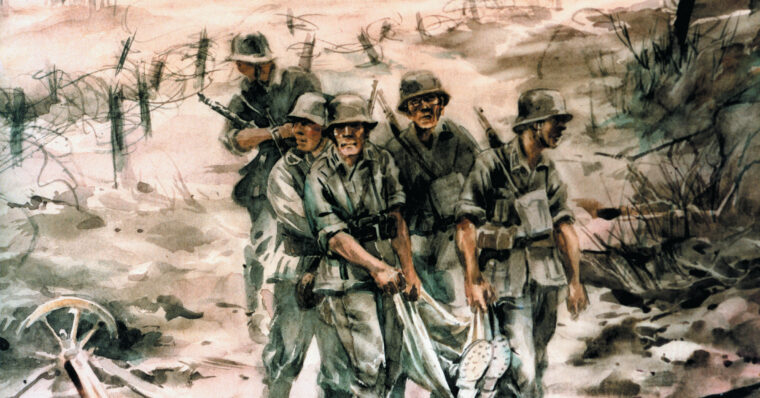
WWII
Prague Uprising in the Spring of 1945
By Pat McTaggartThe first days of May 1945 found the German war machine in absolute chaos. Berlin had fallen, and entire German armies were surrendering en masse. Read more


WWII
The first days of May 1945 found the German war machine in absolute chaos. Berlin had fallen, and entire German armies were surrendering en masse. Read more

WWII
Adolf Hitler believed in Vorsehung (providence). The German leader felt that if anything was going to happen to him, such as assassination, there was nothing he could do about it. Read more

WWII
The story of Hitler’s Bodyguard, the 1st SS Panzer Division Leibstandarte (LAH), in the battle for Bastogne does not begin until after the siege of that city had been raised by the U.S. Read more

WWII
Everyone has seen the now famous photograph of the three firefighters hoisting Old Glory over the ruins of the World Trade Center. Read more

WWII
In June 1940, Italian dictator Benito Mussolini wrestled with a dilemma. German Chancellor Adolf Hitler was the very essence of a victorious warlord. Read more

WWII
During its history, the Lockheed Aircraft Corporation has earned a reputation for building versatile airplanes. Its 1950s era C-130 Hercules is no doubt the most famous, but it was not the first. Read more

WWII
Following service as a lieutenant in the U.S. Army Air Defense Artillery during the early 1970s, Ward Carr decided to remain in Germany, residing in Frankfurt. Read more

WWII
Letters were a valuable commodity to the World War II soldier. They were the link to home and to all things familiar in a most unfamiliar place and time. Read more

WWII
Private First Class Frank Rinaldi cautiously made his way through the dense foliage. He and other soldiers were on patrol when they heard the unmistakable sound of Japanese voices, and they inched their way forward to investigate. Read more

WWII
Throughout his lifetime, FBI Director J. Edgar Hoover always boasted that no enemy agent, either spy or saboteur, ever operated at large in the United States during World War II. Read more

WWII
World War II had been in progress for six weeks when on the evening of October 12, 1939, the German submarine U-47 surfaced off the Orkney Islands at the northern tip of Scotland. Read more

WWII
In truth, it really was not a combat operation. For every airplane lost to enemy action, a hundred were destroyed in accidents. Read more

WWII
By December 1943, the phrase “sunny Italy” had evolved from being a travel agent’s selling point to becoming an ugly joke for the British and American troops of the Allied Fifth Army, advancing north from Naples to Rome. Read more

WWII
A hard-hitting novel that inspired a classic war film, 12 O’Clock High was a very personal project for co-authors Beirne Lay, Jr., Read more

WWII
By February 1945, the green Allied formations that landed on D-Day had become hard professional armies. Army, corps, and division commands had been shaken down and were operating efficiently. Read more

WWII
On the night of November 13, 1941, the British submarine Torbay, accompanied by the Talisman, broke the surface of the Mediterranean off the Cyrenaican coast of Libya and rolled violently in the running seas. Read more

WWII
Following its swift advance to the Rhine, the American 100th (Century) Infantry Division resumed its pursuit of retreating German forces. Read more

WWII
When Private Clarence Garrett of the 28th Regiment, 5th Division, United States Marine Corps, clung to the loose black volcanic sand on the sloping beach of Iwo Jima on Feburary 19, 1945, he probably had no idea that his photograph was being taken. Read more

WWII
On June 10, 1944, as his troop transport churned through the Pacific toward the Japanese-held island of Saipan, Pharmacist’s Mate First Class Stan Bowen wrote a letter to his sweetheart, Marge McCann. Read more

WWII
No Allied field commander in World War II shouldered such heavy burdens, with so few resources and over such a wide area, as did British General Archibald P. Read more